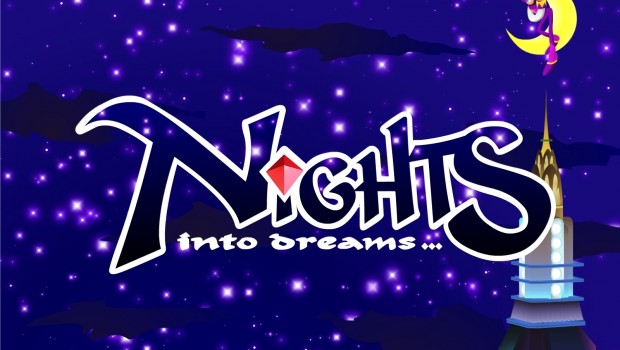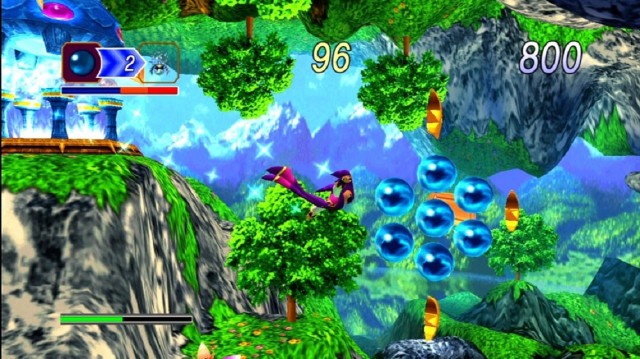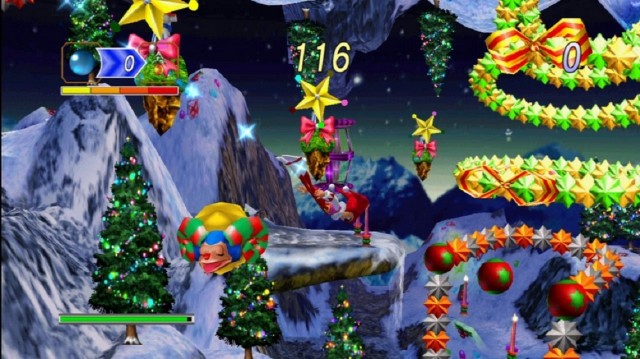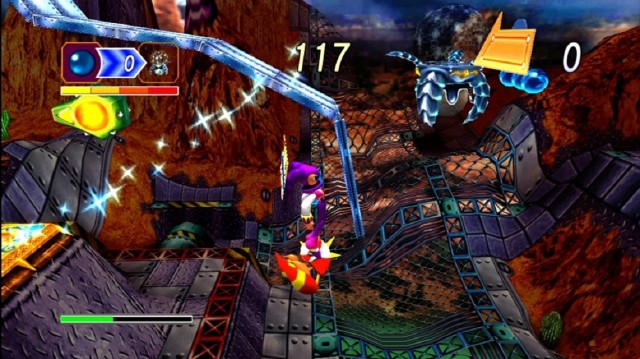NiGHTS Into Dreams… review (XBLA)
NIGHTS Into Dreams… was developed and published by Sega. It was released on October 5, 2012 for 800 MSP. A copy was provided for review purposes.

NiGHTS Into Dreams… like the re-release of Jet Set Radio for XBLA last month, is a game from an era remembered with great fondness by gamers old enough to have played the original in its prime. NiGHTS is a game that dreamed large for its time, and as a historical curiosity, it is outstanding that Sega has seen fit to release it to a wider public. Unfortunately for the last great dream of Sonic Team, while it remains a grand vision with fantastic artistic direction, it has not aged very gracefully.
For anyone reading this review with no prior experience of NiGHTS, it was released for the Sega Saturn in the fall of 1996 on the cusp of the transition from 2D to 3D gaming — for reference, Super Mario 64, largely credited with completing this transition, was released a month afterwards as a release title for the Nintendo 64. NiGHTS (which is both the game’s title and the name of the main character) has its great moments, but they are tarnished by a few annoyances that are signs of the game’s original time period
Here’s what we liked:
High quality port – This is a game that fans hold in high esteem, and it’s clear that Sega does also. The game offers three ways to play: the original Saturn version letterboxed (with a new border taking up the extra space on the margins of your HD television), the original Saturn version stretched, and an HD remastered version. The remaster goes above and beyond a mere texture resizing; for instance, there are added transparency effects that the Saturn simply couldn’t render, and everything looks nice and crisp while remaining extremely faithful to the vision of the original. The inclusion of the Christmas NiGHTS bonus promotional disc is icing on the cake, literally and figuratively — it’s one of the two unlocks available upon completion of the main game.
Stunning art style – In a present-day era full of browns and greens, NiGHTS is a powerful reminder that the games of yesteryear were truly the stuff of dreams. Color abounds here to powerful, effective results. The Nightopians have a variety of interactions with NiGHTS that players may not notice until their second or third trip through the game. Multiple playthroughs are rewarded with lots of these small touches of the type that separate good games from great ones. The soundtrack also draws from an equally pleasant eclectic palette, and is just as inspired as the amazing visuals on display.
Smooth, flowing gameplay – During the levels, the game doles out rewards in chains — each object collected or ring passed through both adds a nominal point value and increases the multiplier for the entire chain. By going fast enough along the correct routes, chains can be extended for great distances, or even across multiple laps of the course in certain stages. This combined with the low time commitment of 480 seconds per stage (split into four 120-second courses) allows for that “just one more attempt” mentality. It’s easy to lose yourself here when the game is at its peak.
Here’s what we didn’t like:
Lack of introductions – Unless players read the included manual, they will very likely have absolutely no idea what to do in order to make progress. The basics is that players must collect 20 blue orbs and deposit them at a marked place in the stage, and then return to the beginning of the course (all tracks wrap from left to right, so merely fly to the right and players will arrive back at the beginning). To collect things, players can either make direct contact with an item, or guide NiGHTS in a circle, collecting everything he circumscribes. After players deposit the orbs, everything is worth double points, so it’s better to get a bunch of orbs early, deposit them, and then spend as much time as possible in the “double point” mode. None of this is shared with players ingame — the lackluster plot is similarly by and large confined to either the manual or to a few closing cutscenes.
Boss stages – The above problem is compounded in the boss stages, which also suffer from a near-complete lack of pacing relative to the tight balance found between speed and control in the main stages. Each boss must be defeated in a different way, and there is no indication as to what must be done (a hint appears after you fail, but it’s not always helpful). There isn’t anything redeeming to say about any of these boss fights — while some are better than others, almost all of them are lackluster in comparison to the meat of the game.
What you see isn’t always what you get – As mentioned before, players cannot shift themselves along the Z-axis as NiGHTS (if players run out of time, then control reverts to one of two children who can — this is largely irrelevant). Upon completion of each course (a quarter of a full stage), the Z-axis perspective is shifted for the player, so that each course takes place in a different part of a stage. Unfortunately, the collectable orbs, stars, and rings for courses are often visible in both the background and foreground. Many of these objects cannot be collected even though you see them onscreen. Players will learn to recognize this, but it does take some time and remains distracting, especially when a giant ring flies into the foreground, obstructing the player’s vision.
NiGHTS was a grand vision at a pivotal moment in the game industry. The hybrid it presents between action game and racing game is both incredibly engaging at times, and unique among games even today. The good steps taken by Sonic Team are unfortunately marred by an equal number of misguided decisions largely resultant by a lack of games to use as a model — this is a game that broke new ground, and it shows, for better and for worse.
While the game is deserving of its devoted fanbase, there are enough problems here that it is difficult to recommend sight unseen. That being said, it’s a rare game that has the vision this game had back in 1996. The demo is unquestionably worth a download, and SEGA has done consumers a great service in presenting such a high quality port of one of its most popular titles.
Score: Try It




